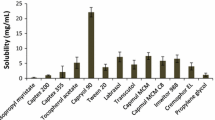Abstract
The purpose of this study was to formulate a gelled self-emulsifying drug delivery system (SEDDS) containing ketoprofen as an intermediate in the development of sustained release solid dosage form. Captex 200 (an oil), Tween 80 (a surfactant), and Capmul MCM (a cosurfactant) were used to formulate SEDDS. Silicon dioxide was used as a gelling agent, which may aid in solidification and retardation of drug release. Effect of concentrations of cosurfactant and gelling agent on emulsification process and in vitro drug diffusion was studied using 32 factorial design. Multiple regression analysis data and response surfaces obtained showed that liquid crystal phase viscosity increased significantly with increasing amount of silicon dioxide, which in turn caused an increase in average droplet size of resultant emulsion and slower drug diffusion. Drug release from the formulation increased with increasing amount of cosurfactant.
Similar content being viewed by others
References
Charman SA, Charman WN, Rogge MC, Wilson TD, Pouton CW. Self-emulsifying drug delivery systems: formulation and biopharmaceutical evaluation of an investigational lipophilic compound.Pharm Res. 1992;9:87–93.
Pouton CW. SEDDS: Assessment of the efficiency of emulsification.Int J Pharm. 1985;27:335–348.
Shah NH, Carvajal MT, Patel CI, Infeld NH, Malick AW. Self-emulsifying drug delivery systems (SEDDS) with polyglycolyzed glycerides for improving in vitro dissolution and oral absorption of lipophilic drugs.Int J Pharm. 1994;106:15–23.
Pouton CW, Charman WN. The potential of oily formulations for drug delivery to the gastro-intestinal tract.Adv Drug Deliv Rev. 1997;25:1–2.
Pouton CW. Formulation of self-emulsifying drug delivery systems.Adv Drug Deliv Rev. 1997;25:47–58.
ConStantinides PP. Lipid microemulsion for improving drug dissolution and oral absorption: physical and biopharmaceutical aspects.Pharm Res. 1995;12:1561–1572.
Craig DQM, Barker SA, Banning D, Booth SW. An investigation into mechanism of self emulsification using particle size analysis and low frequency dielectric spectroscopy.Int J Pharm. 1995;114:103–110.
Porter CJ, Charman WN. In vitro assessment of oral lipid based formulations.Adv Drug Deliv Rev. 2001;50 (suppl 1):S127-S147.
Itoh K, Tozuka Y, Oguchi T, Yamamoto K. Improvement of physicochemical properties of N-4472 part I formulation design by using selfmicroemulsifying system.Int J Pharm. 2002;238:153–160.
Kim H-J, Yoon KA, Hahn M, Park E-S, Chi S-C. Preparation and in vitro evaluation of self-microemulsifying drug delivery systems containing idebenone.Drug Dev Ind Pharm. 2000;26:523–529.
Kommuru TR, Gurley B, Khan MA, Reddy IK. Self-emulsifying drug delivery systems (SEDDS) of coenzyme Q10: formulation development and bioavailability assessment.Int J Pharm. 2001;212:233–246.
Julianto T, Yuen KH, Noor AM. Improved bioavailability of vitamin E with a self emulsifying formulation.Int J Pharm. 2000;200:53–57.
Khoo S-H, Humberstone AJ, Porter CJH, Edwards GA, Charman WN. Formulation design and bioavailability assessment of lipidic self-emulsifying formulations of halofantrine.Int J Pharm. 1998;167:155–164.
Gao Z-G, Choi H-G, Shin H-J, et al. Physicochemical characterization and evaluation of a microemulsion system for oral delivery of cyclosporine A.Int J Pharm. 1998;161:75–86.
Kim JY, Ku YS. Enhanced absorption of indomethacin after oral or rectal administration of a self-emulsifying system containing indomethacin to rats.Int J Pharm. 2000;194:81–89.
Vergote GJ, Vervaet C, Van Driessche I, et al. An oral controlled release matrix pellet formulation containing nanocrystalline ketoprofen.Int J Pharm. 2001;219:81–87.
Yamada T, Onishi H, Machida Y. Sustained release ketoprofen microparticles with ethylcellulose and carboxymethylethylcellulose.J Control Release. 2001;75:271–282.
Roda A, Sabatini L, Mirasoli M, Baraldini M, Roda E. Bioavailability of a new ketoprofen formulation for once-daily oral administration.Int J Pharm. 2002;241:165–172.
El-Kamel AH, Sokar MS, Al Gamal SS, Naggar VF. Preparation and evaluation of ketoprofen floating oral delivery system.Int J Pharm. 2001;220:13–21.
Rhee Y-S, Choi J-G, Park E-S, Chi S-C. Transdermal delivery of ketoprofen using microemulsions.Int J Pharm. 2001;228:161–170.
Nazzal S, Smalyukh II, Lavrentovich OD, Khan MA. Preparation and in vitro characterization of a eutectic based semisolid self-nanoemulsified drug delivery system (SNEDDS) of ubiquinone: mechanism and progress of emulsion formation.Int J Pharm. 2002;235:247–265.
Attama AA, Nzekwe IT, Nnamani PO, Adikwu MU, Onugu CO. The use of solid self-emulsifying systems in the delivery of diclofenac.Int J Pharm. 2003;262:23–28.
Newton M, Petersson J, Podczeck F, Clarke A, Booth S. The influence of formulation variables on the properties of pellets containing a self-emulsifying mixture.J Pharm Sci. 2001;90:987–995.
Schwarz J. Solid self-emulsifying dosage form for improved delivery of poorly soluble hydrophobic compounds and the process of preparation thereof. US patent application No. 2003 0 072 789. 2003.
Raghavan SR, Hou J, Baker GL, Khan SA. Colloidal interactions between particles with tethered nonpolar chains dispersed in polar media: direct correlation between dynamic rheology and interaction parameters.Langmuir. 2000;16:1066–1077.
Raghavan SR, Walls HJ, Khan SA. Rheology of silica dispersions in organic liquids: new evidence for solvation forces dictated by hydrogen bonding.Langmuir. 2000;16:7920–7930.
Schott H. Rheology. In:Remington's Pharmaceutical Sciences. 18th ed. Easton, PA: Mack Publishing Co; 1990:310–326.
Author information
Authors and Affiliations
Corresponding author
Rights and permissions
About this article
Cite this article
Patil, P., Joshi, P. & Paradkar, A. Effect of formulation variables on preparation and evaluation of gelled self-emulsifying drug delivery system (SEDDS) of ketoprofen. AAPS PharmSciTech 5, 42 (2004). https://doi.org/10.1208/pt050342
Received:
Accepted:
DOI: https://doi.org/10.1208/pt050342




